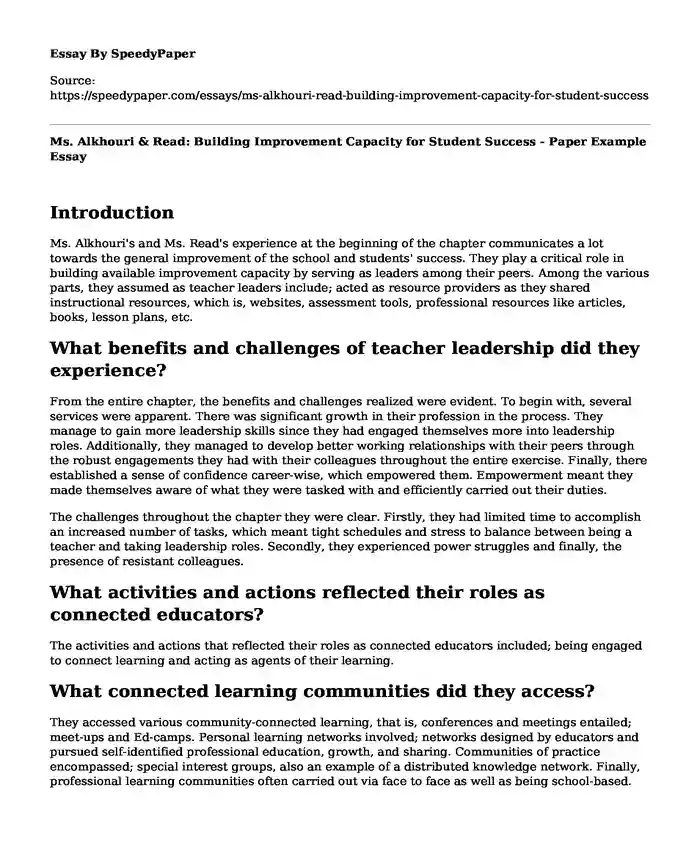
| Type of paper: | Essay |
| Categories: | Leadership analysis Students |
| Pages: | 2 |
| Wordcount: | 411 words |
Introduction
Ms. Alkhouri's and Ms. Read's experience at the beginning of the chapter communicates a lot towards the general improvement of the school and students' success. They play a critical role in building available improvement capacity by serving as leaders among their peers. Among the various parts, they assumed as teacher leaders include; acted as resource providers as they shared instructional resources, which is, websites, assessment tools, professional resources like articles, books, lesson plans, etc.
What benefits and challenges of teacher leadership did they experience?
From the entire chapter, the benefits and challenges realized were evident. To begin with, several services were apparent. There was significant growth in their profession in the process. They manage to gain more leadership skills since they had engaged themselves more into leadership roles. Additionally, they managed to develop better working relationships with their peers through the robust engagements they had with their colleagues throughout the entire exercise. Finally, there established a sense of confidence career-wise, which empowered them. Empowerment meant they made themselves aware of what they were tasked with and efficiently carried out their duties.
The challenges throughout the chapter they were clear. Firstly, they had limited time to accomplish an increased number of tasks, which meant tight schedules and stress to balance between being a teacher and taking leadership roles. Secondly, they experienced power struggles and finally, the presence of resistant colleagues.
What activities and actions reflected their roles as connected educators?
The activities and actions that reflected their roles as connected educators included; being engaged to connect learning and acting as agents of their learning.
What connected learning communities did they access?
They accessed various community-connected learning, that is, conferences and meetings entailed; meet-ups and Ed-camps. Personal learning networks involved; networks designed by educators and pursued self-identified professional education, growth, and sharing. Communities of practice encompassed; special interest groups, also an example of a distributed knowledge network. Finally, professional learning communities often carried out via face to face as well as being school-based.
What benefits and challenges of being connected educators did they experience?
Challenges are ever-present in the field of education, similar to any professional area. The predominant challenge was the reliance on internet access since the essential resources mainly were through websites. The other imminent challenge was limited time to engage them in more work that is, sharpen their skills to the hurdles they faced.
Reference
Hughes, M. D. Roblyer; Joan E. Integrating Educational Technology into Teaching. Pearson Education (US), 2018.
Cite this page
Ms. Alkhouri & Read: Building Improvement Capacity for Student Success - Paper Example. (2023, Nov 30). Retrieved from https://speedypaper.net/essays/ms-alkhouri-read-building-improvement-capacity-for-student-success
Request Removal
If you are the original author of this essay and no longer wish to have it published on the SpeedyPaper website, please click below to request its removal:
- Note to Roommate - Free Essay Example
- Essay Example on Nurse Leadership and Management in Patient Satisfaction
- Approaches to Management and Leadership, Free Essay for You
- Education Essay Example: Games and Sports in College Curriculum
- Essay Sample on Andrew Johnson's Tragic Flaw
- Case Study Example for You: Motivation and Leadership Strategies
- My Career Goal. Free Essay Example
Popular categories




